Over the Years
Home > Over the Years > Over the Fiscal Years (2000 APR - 2010 MAR) > Korea: Medical Delegation for Radiation-exposed patients
Korea: Medical Delegation for Radiation-exposed patients
HICARE invited a medical delegation to aid in treatment of radiation-exposed patients, consisting of eleven members from the National Radiation Emergency Medical Center (NREMC) and Korean Institute of Radiological & Medical Sciences (KIRAMS) in Korea for one-week training at the Hiroshima University (other HICARE-related organizations).
Dr. Choi, Chang-Woon, leader of the Delegation, delivered a speech as a panel member at the "HICARE International Symposium Commemorating the 15th Anniversary of the Foundation," held on September 14, 2006.
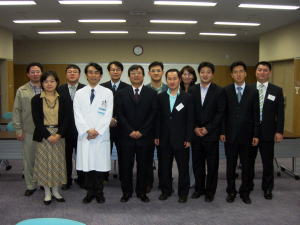
Dr. Choi, Chang-Woon (third from the left in the front row) and delegation members,with Dr. Tanigawa, Professor of Hiroshima University Hospital (HICARE Executive Secretary) (second from the left in the front row)
Members:
| Leader | Choi,Chang-Woon | Director, NREMC, KIRAMS |
| Member | Kim, Sun-Sil | R.N., Radiation Emergency Medical Team, NREMC, KIRAMS |
| Lim, Nam-Hui | R.N., Radiation Emergency Medical Team, NREMC, KIRAMS | |
| Choi, Won-Sik | Administrator, Administrative Assistance Team, NREMC, KIRAMS | |
| Lee, Shin-Jae | Administrator, Administrative Assistance Team, NREMC, KIRAMS | |
| Choi, Dai-Hai | Chief, Dept. of Emergency Medicine, Dongguk Univ., Gyongju Hospital | |
| Lee, Kyung-Woo | Chief, Dept. of Emergency Medicine, Gyeongsang National Univ. Hospital | |
| Yang, Jae-Wung | Chief, Hospital Affairs Team, Gijang Medical Center | |
| Park, Soo-Seok | Chief, Dept. of Diagnostic Radiology, Uljin Medical Center | |
| Yun, Sun-Ho | Chief, Dept. of Diagnostic Radiology, Yeonggwang Christian Hospital | |
| and other one member |
Period:
September 11 to 14, 2006
Training Schedule (in order of occurrence):
Hiroshima University Institute for Radiation, Biology, & Medicine
Hiroshima University Graduate School
Hiroshima A-bomb Casualty Council
Radiation Effects Research Foundation
Visit to the Peace Memorial Museum and other A-bomb related sites
Choi,Chang-Woon Director, NREMC, KIRAMS
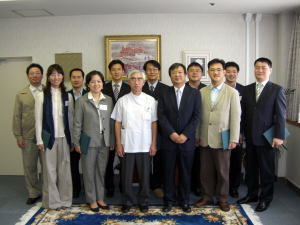
Dr. Choi, Chang-Woon (third from the right in the front row), with Dr. Dohy, HICARE President (third from the left in the front row)
Impressions:
I would like to thank everyone involved with regards to the HICARE training program. I think that HICARE is a wonderful system which has, via collaboration with locals governments, hospitals, and universities, continued to produce medical contributions and studies regarding A-bomb survivors. I was especially impressed by the professional research carried out by each organization of HICARE.
I feel it necessary that an advisory committee on national radiation emergency medicine be established in Korea to coordinate several projects. Additionally, I think that we should promote international relations via supporting both research as well as a radiation emergency system. I hope that we are able to deepen our mutual relationship between HICARE and the Korean NREMC.
In conclusion, I would like to thank the HICARE concerned for their sincere consideration during our training.
Medical Activities in Korea:
I am working at the NREMC, KIRAMS, and am mainly responsible for medical treatment in the event of a radiation accident in Korea.
At present, although I focus on education and training for medical staff regarding radiation emergency medicine, I would like to learn more about medical research and international cooperation.
Kim, Sun-Sil R.N., Radiation Emergency Medical Team, NREMC, KIRAMS
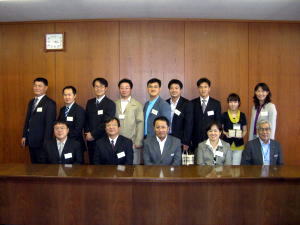
Ms. Kim, Sun-Sil (second from the right in the front row), with Mr. Matsumura, Deputy Director-General, Hiroshima City Government (third from the left in the front row)
Impressions:
I would like to thank HICARE for its well-planned and well-organized research and training program. I believe HICARE's supports for radiation-exposed patients greatly contributes to the human welfare.
Thank you very much.
Medical Activities in Korea:
To conduct education and training to strengthen the radiation emergency system
To prepare for radiation-related treatment in the event of terrorism
To hold emergency drills in the event of a radiation accidents at a nuclear power plants in Korea
Choi, Won-Sik Administrator, Administrative Assistance Team, NREMC, KIRAMS
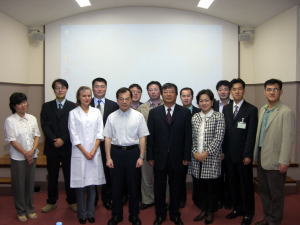
Mr. Choi, Won-Sik (second from the right), with Dr. Neriishi, Assistant Department Chief, Clinical Studies Dept. Radiation Effects Research Foundation (second from the left in the front row)
Impressions:
I feel quite lucky to have participated in this training program, an opportunity often not available to administrative staff. I would like to thank everyone at HICARE for their efforts, particularly Dr. Dohy, HICARE President.
Previously vague concepts have become much clearer to me. Now, bringing those ideas back to Korea, I find I can provide more information, a more complete treatment, than prior to the training. I will continue, to the best of my ability, to utilize this new knowledge in my work. I hope very much that the HICARE program grows and expands its scope.
Thank you very much!
Medical Activities in Korea:
I am in charge of administrative issues, working within the Administrative Assistance Team, NREMC, KIRAMS. I prepare to support measures aimed in facilitating radiation emergency medicine.
Regarding emergency preparations, I am responsible for purchases, installations, and management of radiation measuring equipment and emergency medical equipment necessary for the Center. I manage a budget, providing funds necessary for the management of the Center, establishment of project plans, personnel management, facilities management, cooperative promotion including conclusion of MOV with related organizations, and administrative affairs related to preparation for radiation terrorism or accidents.
I hope our Center further develops via a cooperation with HICARE.
Lee, Shin-Jae Administrator, Administrative Assistance Team, NREMC, KIRAMS
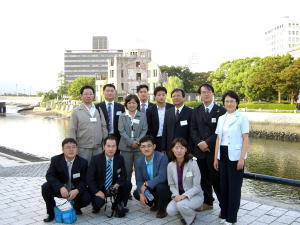
Mr. Lee, Shin-Jae (fourth from the right in the back row), with A-bomb Dome (World Cultural Heritage) for a background
Impressions:
Prior to coming, I was not particularly interested in Hiroshima. However, during the training my interest in the place grew. I would like to visit Hiroshima with my family once again, visiting both Hiroshima Castle as well as Miyajima.
Choi, Dai-Hai Chief, Dept. of Emergency Medicine, Dongguk Univ. Gyongju Hospital
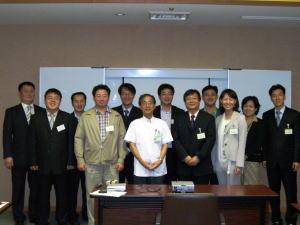
Dr. Choi, Dai-Hai (second from the left in the front row), with Dr. Sasaki, Director, Health Management and Promotion Center, Hiroshima A-bomb Casualty Council (HICARE Executive Secretary) (third from the left in the front row)
Impressions:
As a preparatory measure for a radiation accident in Korea, I feel that HICARE's training contributes significantly. It is more important, of course to prevent the accident. In addition, I feel it important to plan and carry out programs to enhance citizens?Eunderstanding of nuclear power, as they often hold vague and unfounded fears. Transparent systems of both administration and management are necessary as well.
Medical Activities in Korea:
Chief Professor, Dept. of Emergency Medicine, Dongguk Univ. Medical College
Chief, Dept. of Emergency Medicine, Dongguk Univ. Gyongju Hospital
Member, Korean Emergency Medicine Association
Member, Korean Traumatology Association
Member, Korean Clinical toxicity Association
Member, Child Abuse Prevention Committee, Dep. of Health and Welfare, Gyongju Region
Advisory Doctor for Emergency treatment, Fire Headquarter, Gyongju Region
Advisory Doctor for Emergency treatment, Fire Dept., Gyongju Region
Member, Infection Control Committee, Fire Dept., Gyongju Region
Leader, First Emergency Medical Organization for Radiation Accident Protection Designated by Agency for Science and Technology
Professor, Dept. of Emergency Medicine, P'ohang Good Neighbor University
Director, Education Center to Save Lives of Dongguk Univ. Gyongju Hospital Designated by Korean Cardiopulmonary Resuscitation Association and American Heart Association
Lee, Kyung-Woo Chief, Dept. of Emergency Medicine, Gyeongsang National Univ. Hospital
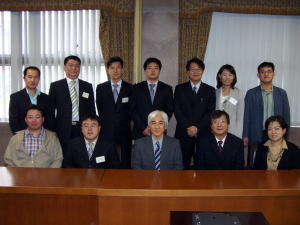
Dr. Lee, Kyung-Woo (second from the left in the front row), with Dr. Kamiya, Professor of Hiroshima University Institute for Radiaion Biology and Medicine (third from the left in the front row)
Impressions:
Hiroshima has developed significantly since its disasters of the past. In addition, numerous medical institutions seem to be engaged in collaborative problem solving. I hope that exchange and cooperation with Korea in the field of radiation medicine will continue long into the future.
Medical Activities:
I am working as doctor specializing in emergency medicine and as professor at the Dept. of Emergency Medicine, Gyeongsang National Univ. Hospital, located in Jinju City in Gyeongsangnam-do.
I treat the patients who come into the emergency room of the hospital.
I am also in charge of the education and training of medical students, and also participate in research activities.
My main specialties include cardiopulmonary resuscitation, toxicology, and traumatology, in addition to teaching CPR in Basic Life Support (BLS) (lead by the American Heart Association. )
Additionally, I work as medical staff at the second radiation emergency hospital designated by NREMC.
Yang, Jae-Wung Chief, Hospital Affairs Team, Gijang Medical Center
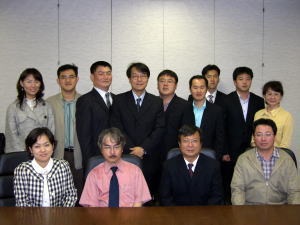
Dr. Yang, Jae-Wung (fourth from the left in the back row), with Dr. Yanagida, Permanent Executive Director, Hiroshima Medical Association (HICARE Chief Executive Secretary) (second from the left in the front row)
Impressions:
Disregarding the similarities of basic medical treatments and education, there are some differences between medical treatment in Korea and in Japan. As a result of this, the training was most educational. I was quite surprised to learn of the large amount of materials and research regarding A-bomb survivors.
This training program has inspiried me to change my thinking regarding many issues.
I would also like to thank the staff, both at KIRAMS and HICARE, for giving me the chance to participate in this training.
In addition, my very deepest thanks to all the HICARE staff who took care of us during our stay in Japan.
Park, Soo-Seok Chief, Dept. of Diagnostic Radiology, Uljin Medical Center
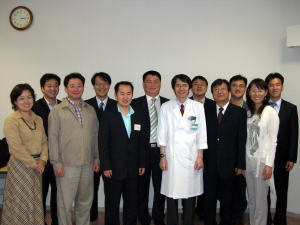
Mr. Park, Soo-Seok (fifth from the left), with Dr. Hide, Professor, Hiroshima University Hospital (sixth from the left)
Impressions:
HICARE’s training was both professional as well as precise.
HICARE has accumulated data on A-bomb survivors for 60 years, and is still continuing research as we speak. Utilizing this research, I think it magnificient how HICARE tries to advance its research activities, cooperating internationally cooperation with other agencies engaged in similar research matters.
Additionally, I was surprised that HICARE perfectly prepares for equipments and facilities in case of an emergency, effectively collaborated with the National Government and local governments as well as each hospital. Especially, it was beneficial to receive the surprising lecture on transplanting skins.
Medical Activities in Korea:
I live in Uljin City, about 250 Km east from Seoul, Korea. Uljin is located in the northernmost area of the Gyeongsangbuk-do region, and borders Gangwon-do.
I am a chief of the Diagnostic Radiology Dept., Uljin Medical Center.
I mainly take charge of CT examinations. I manage staff aiming to minimize radiation exposure during examination, ensuring proper x-rays and x-ray technique.
In addition, responsible for radiation protection management during examinations, I try to monitor the effects on medical staff and engineers, measuring radiation exposure both internally and externally, as well as conducting medical check-ups once a year.
Yun, Sun-Ho Chief, Dept. of Diagnostic Radiology, Yeonggwang Christian Hospital
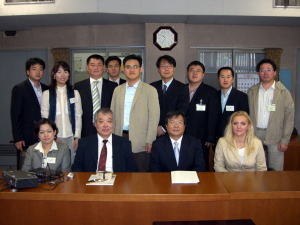
Mr. Yun (third from the left in the back row), with Dr. Hoshi, Professor, Hiroshima University Institute for Radiation Biology and Medicine (HICARE Executive Secretary) (second from the left in the front row)
Impressions:
I was quite nervous, as this was my first time training abroad. Though the HICARE training was somewhat difficult for me, it was significantly educational. Some of the lecture content seemed to overlap that which was covered at KIRAMS in Korea, but ultimately I thought that the training contributed to my clinical activities in the future. I observed and learned systematic research procedures, various clinical experiments, comprehensive studies, as well as visited medical organizations in the city which have significant experience treating the effects of radiation exposure.
Given increasing concern regarding radiation around the world, I think training such as this will greatly contribute to promoting stable and continual development, utilizing radiation positively in the future.
Despite the short period of time, via this training I feel I can now contribute new things to the medical community.
Medical Activities in Korea:
I work at the Dept. of Diagnostic Radiology, Yeonggwang Christian Hospital, in Yeonggwang City of Jeollanam-do region, a city of delicious foods and tradition, located in the south-west of Korea. I think that residents here concerned about radiation much more than other areas; there are a number of operational nuclear power plants in the vicinity.
I mainly conduct basic radiation check-ups for nearby residents and employees, both at the plants themselves as well as nearby companies. I especially focus on the promotion of health care for the residents.
In addition, at the Psychiatric Dept. of the hospital, we carry out clinical activities in the field of psychiatric health care for stresses caused by the fear of radiation accidents or exposures. We also take into consideration various treatments for conditions such as senile dementia, alcohol-related disease, and internal diseases.
Thus, my main work is related to radiation, and as such increased knowledge of the topic gives me the ability to work more comprehensively as a clinical practitioner. I am proud that my medical activities contribute directly to the health people living nearby.
Thank you very much.




